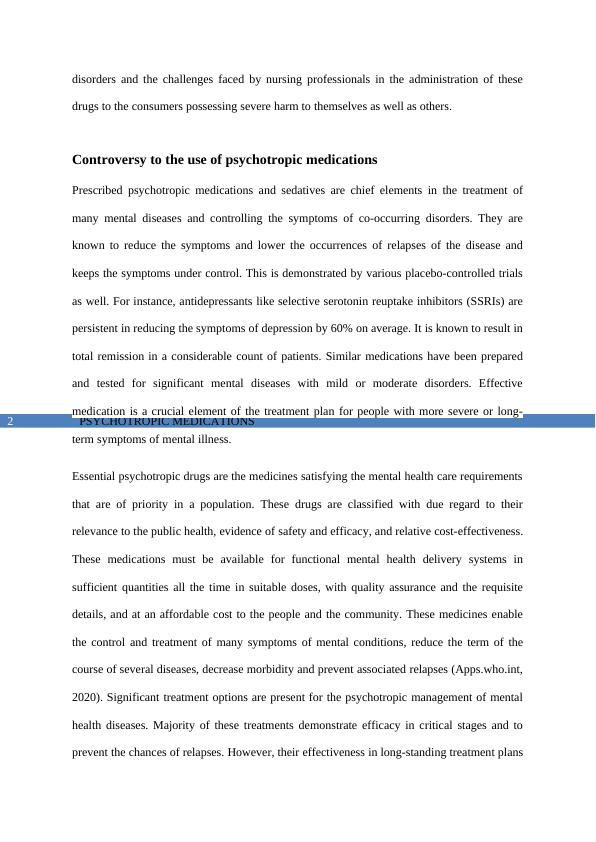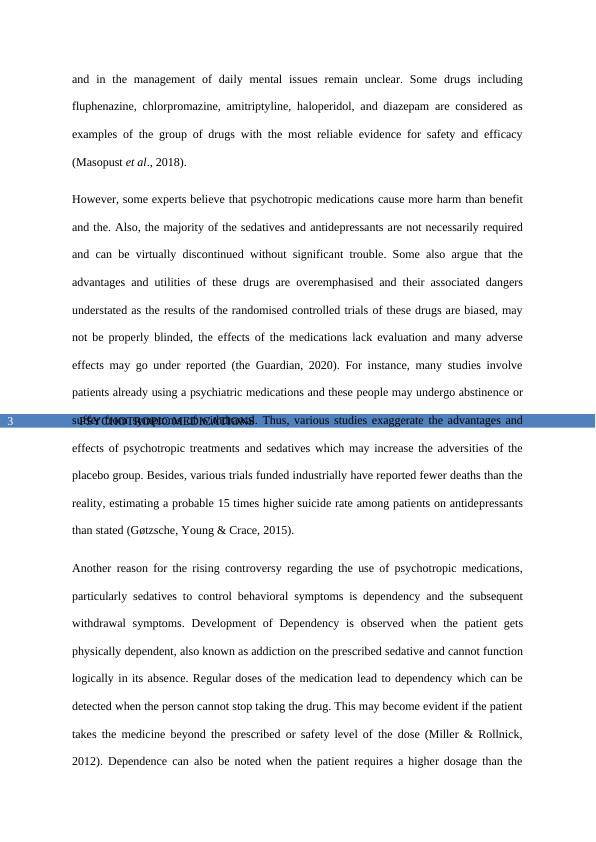Free Assignment on Psychotropic Medications
11 Pages2974 Words24 Views
Added on 2022-08-24
Free Assignment on Psychotropic Medications
Added on 2022-08-24
ShareRelated Documents
Running head: PSYCHOTROPIC MEDICATIONS
Mental healthcare medication and challenges
Name of the Student:
Name of the University:
Author Note:
Mental healthcare medication and challenges
Name of the Student:
Name of the University:
Author Note:

PSYCHOTROPIC MEDICATIONS1
Introduction
Psychotropic medication consists of a wide range of drugs that function by altering the levels
of chemicals in the brain or neurotransmitters such as serotonin, dopamine, norepinephrine
and similar chemicals. The psychotropic medications can be classified into five major groups,
namely antidepressants, antipsychotics, stimulants, anti-anxiety drugs and mood stabilizers.
Some of these may also lead to severe ill-effects and are administered only under the
supervision of healthcare providers. Medical experts are increasingly prescribing
psychotropic medications to patients with mental illnesses. This is because these drugs target
the central nervous system of the individual, reduce the behavioral symptoms exhibited by
the patient, improving the prognosis of the treatment and the overall health status of the
person. Despite the useful nature of these medications, evidence display that the adherence of
patients with mental diseases to these medications is considered low. A possible explanation
for low adherence can be the associated side-effects. Some of the most common adverse
effects include weight gain, fatigue, sleep disturbances, appetite modifications and emotional
swings (Ferreira et al., 2017).
Along with the benefits of using psychotropic drugs for controlling the symptoms of mental
diseases, it is accompanied by various side-effects and mismanagement on the part of the
healthcare providers. Often, high doses of a multitude of these drugs are prescribed for
prolonged periods without sufficient follow-up with its efficacy. These reasons, a mixture of
the benefits and associated challenges, have led to the controversy regarding the use of
psychotropic drugs and sedatives to control the signs and symptoms in people with mental
conditions (Goldacre, 2012). This paper critically discusses the controversy regarding the use
of psychotropic drugs to control the behavioral symptoms of people experiencing mental
Introduction
Psychotropic medication consists of a wide range of drugs that function by altering the levels
of chemicals in the brain or neurotransmitters such as serotonin, dopamine, norepinephrine
and similar chemicals. The psychotropic medications can be classified into five major groups,
namely antidepressants, antipsychotics, stimulants, anti-anxiety drugs and mood stabilizers.
Some of these may also lead to severe ill-effects and are administered only under the
supervision of healthcare providers. Medical experts are increasingly prescribing
psychotropic medications to patients with mental illnesses. This is because these drugs target
the central nervous system of the individual, reduce the behavioral symptoms exhibited by
the patient, improving the prognosis of the treatment and the overall health status of the
person. Despite the useful nature of these medications, evidence display that the adherence of
patients with mental diseases to these medications is considered low. A possible explanation
for low adherence can be the associated side-effects. Some of the most common adverse
effects include weight gain, fatigue, sleep disturbances, appetite modifications and emotional
swings (Ferreira et al., 2017).
Along with the benefits of using psychotropic drugs for controlling the symptoms of mental
diseases, it is accompanied by various side-effects and mismanagement on the part of the
healthcare providers. Often, high doses of a multitude of these drugs are prescribed for
prolonged periods without sufficient follow-up with its efficacy. These reasons, a mixture of
the benefits and associated challenges, have led to the controversy regarding the use of
psychotropic drugs and sedatives to control the signs and symptoms in people with mental
conditions (Goldacre, 2012). This paper critically discusses the controversy regarding the use
of psychotropic drugs to control the behavioral symptoms of people experiencing mental

PSYCHOTROPIC MEDICATIONS2
disorders and the challenges faced by nursing professionals in the administration of these
drugs to the consumers possessing severe harm to themselves as well as others.
Controversy to the use of psychotropic medications
Prescribed psychotropic medications and sedatives are chief elements in the treatment of
many mental diseases and controlling the symptoms of co-occurring disorders. They are
known to reduce the symptoms and lower the occurrences of relapses of the disease and
keeps the symptoms under control. This is demonstrated by various placebo-controlled trials
as well. For instance, antidepressants like selective serotonin reuptake inhibitors (SSRIs) are
persistent in reducing the symptoms of depression by 60% on average. It is known to result in
total remission in a considerable count of patients. Similar medications have been prepared
and tested for significant mental diseases with mild or moderate disorders. Effective
medication is a crucial element of the treatment plan for people with more severe or long-
term symptoms of mental illness.
Essential psychotropic drugs are the medicines satisfying the mental health care requirements
that are of priority in a population. These drugs are classified with due regard to their
relevance to the public health, evidence of safety and efficacy, and relative cost-effectiveness.
These medications must be available for functional mental health delivery systems in
sufficient quantities all the time in suitable doses, with quality assurance and the requisite
details, and at an affordable cost to the people and the community. These medicines enable
the control and treatment of many symptoms of mental conditions, reduce the term of the
course of several diseases, decrease morbidity and prevent associated relapses (Apps.who.int,
2020). Significant treatment options are present for the psychotropic management of mental
health diseases. Majority of these treatments demonstrate efficacy in critical stages and to
prevent the chances of relapses. However, their effectiveness in long-standing treatment plans
disorders and the challenges faced by nursing professionals in the administration of these
drugs to the consumers possessing severe harm to themselves as well as others.
Controversy to the use of psychotropic medications
Prescribed psychotropic medications and sedatives are chief elements in the treatment of
many mental diseases and controlling the symptoms of co-occurring disorders. They are
known to reduce the symptoms and lower the occurrences of relapses of the disease and
keeps the symptoms under control. This is demonstrated by various placebo-controlled trials
as well. For instance, antidepressants like selective serotonin reuptake inhibitors (SSRIs) are
persistent in reducing the symptoms of depression by 60% on average. It is known to result in
total remission in a considerable count of patients. Similar medications have been prepared
and tested for significant mental diseases with mild or moderate disorders. Effective
medication is a crucial element of the treatment plan for people with more severe or long-
term symptoms of mental illness.
Essential psychotropic drugs are the medicines satisfying the mental health care requirements
that are of priority in a population. These drugs are classified with due regard to their
relevance to the public health, evidence of safety and efficacy, and relative cost-effectiveness.
These medications must be available for functional mental health delivery systems in
sufficient quantities all the time in suitable doses, with quality assurance and the requisite
details, and at an affordable cost to the people and the community. These medicines enable
the control and treatment of many symptoms of mental conditions, reduce the term of the
course of several diseases, decrease morbidity and prevent associated relapses (Apps.who.int,
2020). Significant treatment options are present for the psychotropic management of mental
health diseases. Majority of these treatments demonstrate efficacy in critical stages and to
prevent the chances of relapses. However, their effectiveness in long-standing treatment plans

PSYCHOTROPIC MEDICATIONS3
and in the management of daily mental issues remain unclear. Some drugs including
fluphenazine, chlorpromazine, amitriptyline, haloperidol, and diazepam are considered as
examples of the group of drugs with the most reliable evidence for safety and efficacy
(Masopust et al., 2018).
However, some experts believe that psychotropic medications cause more harm than benefit
and the. Also, the majority of the sedatives and antidepressants are not necessarily required
and can be virtually discontinued without significant trouble. Some also argue that the
advantages and utilities of these drugs are overemphasised and their associated dangers
understated as the results of the randomised controlled trials of these drugs are biased, may
not be properly blinded, the effects of the medications lack evaluation and many adverse
effects may go under reported (the Guardian, 2020). For instance, many studies involve
patients already using a psychiatric medications and these people may undergo abstinence or
suffer from symptoms of withdrawal. Thus, various studies exaggerate the advantages and
effects of psychotropic treatments and sedatives which may increase the adversities of the
placebo group. Besides, various trials funded industrially have reported fewer deaths than the
reality, estimating a probable 15 times higher suicide rate among patients on antidepressants
than stated (Gøtzsche, Young & Crace, 2015).
Another reason for the rising controversy regarding the use of psychotropic medications,
particularly sedatives to control behavioral symptoms is dependency and the subsequent
withdrawal symptoms. Development of Dependency is observed when the patient gets
physically dependent, also known as addiction on the prescribed sedative and cannot function
logically in its absence. Regular doses of the medication lead to dependency which can be
detected when the person cannot stop taking the drug. This may become evident if the patient
takes the medicine beyond the prescribed or safety level of the dose (Miller & Rollnick,
2012). Dependence can also be noted when the patient requires a higher dosage than the
and in the management of daily mental issues remain unclear. Some drugs including
fluphenazine, chlorpromazine, amitriptyline, haloperidol, and diazepam are considered as
examples of the group of drugs with the most reliable evidence for safety and efficacy
(Masopust et al., 2018).
However, some experts believe that psychotropic medications cause more harm than benefit
and the. Also, the majority of the sedatives and antidepressants are not necessarily required
and can be virtually discontinued without significant trouble. Some also argue that the
advantages and utilities of these drugs are overemphasised and their associated dangers
understated as the results of the randomised controlled trials of these drugs are biased, may
not be properly blinded, the effects of the medications lack evaluation and many adverse
effects may go under reported (the Guardian, 2020). For instance, many studies involve
patients already using a psychiatric medications and these people may undergo abstinence or
suffer from symptoms of withdrawal. Thus, various studies exaggerate the advantages and
effects of psychotropic treatments and sedatives which may increase the adversities of the
placebo group. Besides, various trials funded industrially have reported fewer deaths than the
reality, estimating a probable 15 times higher suicide rate among patients on antidepressants
than stated (Gøtzsche, Young & Crace, 2015).
Another reason for the rising controversy regarding the use of psychotropic medications,
particularly sedatives to control behavioral symptoms is dependency and the subsequent
withdrawal symptoms. Development of Dependency is observed when the patient gets
physically dependent, also known as addiction on the prescribed sedative and cannot function
logically in its absence. Regular doses of the medication lead to dependency which can be
detected when the person cannot stop taking the drug. This may become evident if the patient
takes the medicine beyond the prescribed or safety level of the dose (Miller & Rollnick,
2012). Dependence can also be noted when the patient requires a higher dosage than the

End of preview
Want to access all the pages? Upload your documents or become a member.
Related Documents
Alcohol and Mental Health | Essaylg...
|11
|3144
|30
Controversy Related to the Use of Sedative Medicationslg...
|12
|3231
|25
Psychotropic Drug | Mental Health Nursinglg...
|12
|3304
|17
Side Effects of Psychotropic Medications and Challenges for Nurseslg...
|10
|2476
|67
Psychtropic Drugs - Restrictive and coercive practices in mental health carelg...
|12
|3159
|24
International Journal Of Developmental Disabilitieslg...
|11
|2826
|14
